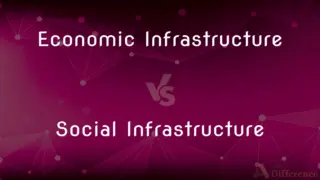RMP vs. SMP — What's the Difference?
Edited by Tayyaba Rehman — By Fiza Rafique — Published on July 21, 2024
RMP (Risk Management Plan) focuses on identifying, assessing, and mitigating risks in projects or organizations, while SMP (Strategic Management Plan) outlines an organization's strategic goals, including vision, mission, and long-term objectives.

Difference Between RMP and SMP
Table of Contents
ADVERTISEMENT
Key Differences
An RMP, or Risk Management Plan, is a comprehensive document that outlines how an organization identifies, assesses, and mitigates risks associated with its projects or operational activities. It includes methodologies for risk identification, risk impact assessment, strategies for risk mitigation, and protocols for monitoring and reporting risks. The primary focus is on minimizing potential negative impacts on project objectives or organizational goals.
An SMP, or Strategic Management Plan, serves as a roadmap for an organization, defining its vision, mission, strategic objectives, and the actions needed to achieve these goals. It encompasses long-term planning, resource allocation, and setting priorities to ensure the organization's growth and sustainability. The SMP is broader in scope, focusing on leveraging opportunities and managing external and internal factors that affect the organization's success.
The RMP is centered around preventing and managing potential threats and vulnerabilities, while the SMP is oriented towards growth, competitive advantage, and long-term success. The RMP is typically more dynamic, requiring regular updates as new risks emerge, whereas the SMP is reviewed and revised over longer strategic periods, reflecting shifts in organizational direction or external environments.
Both plans are crucial for organizational success but serve different purposes. The RMP is a tool for risk mitigation, essential for project management and operational stability. The SMP, on the other hand, guides the overall strategic direction, encompassing aspects like market positioning, innovation, and stakeholder engagement.
Integrating RMP elements within the broader SMP can provide a holistic approach to strategic planning, ensuring that strategic objectives are pursued with an awareness of potential risks. This integration helps in aligning risk management strategies with long-term organizational goals, thereby enhancing resilience and adaptability.
ADVERTISEMENT
Comparison Chart
Focus
Identifying and mitigating risks.
Setting and achieving strategic goals.
Scope
Specific to projects or operational risks.
Broad, encompassing overall organizational direction.
Objective
Minimize potential negative impacts on objectives.
Ensure growth, competitiveness, and long-term success.
Key Components
Risk identification, assessment, mitigation strategies.
Vision, mission, strategic objectives, action plans.
Review Cycle
Regular updates as risks evolve.
Longer-term revisions aligned with strategic periods.
Compare with Definitions
RMP
Essential for project management.
Implementing an RMP ensured the project remained on schedule despite unforeseen challenges.
SMP
Outlines long-term goals.
The company's SMP focused on expanding into new international markets over the next five years.
RMP
Framework for risk mitigation.
The construction project's RMP addressed potential safety and supply chain risks.
SMP
Integrates stakeholder engagement.
The SMP included initiatives for enhancing partnerships with key stakeholders to support strategic goals.
RMP
Focuses on contingency planning.
The RMP outlined contingency plans for critical path risks in the project timeline.
SMP
Includes vision and mission.
The SMP began with a clear articulation of the company's vision for innovation and customer service excellence.
RMP
Dynamic and adaptable.
The RMP was regularly updated to reflect new financial and regulatory risks.
SMP
Guides resource allocation.
The SMP directed significant investment towards research and development to support long-term growth.
RMP
Involves risk assessment.
The RMP included a detailed risk assessment matrix to evaluate project vulnerabilities.
SMP
Addresses competitive positioning.
Strategic objectives in the SMP aimed at achieving market leadership in sustainable products.
Common Curiosities
What is the purpose of an RMP?
An RMP aims to identify, assess, and mitigate risks to minimize their impact on project objectives or organizational operations.
How often should an RMP be updated?
An RMP should be updated regularly as new risks emerge and circumstances change, unlike an SMP, which is reviewed over longer strategic periods.
How does an SMP differ from an RMP in scope?
An SMP has a broader scope, focusing on overall strategic goals and long-term organizational direction, while an RMP is more focused on specific risks.
Who should be involved in creating an SMP?
Developing an SMP is a strategic process involving senior management, strategic planners, and key stakeholders.
Can an RMP be part of an SMP?
Yes, risk management elements from an RMP can be integrated into an SMP to ensure strategic goals are pursued with an awareness of potential risks.
Can a small business benefit from an SMP?
Yes, even small businesses can benefit from an SMP by providing a clear direction and framework for growth.
Is an SMP necessary for all organizations?
Yes, an SMP is crucial for any organization aiming for sustained growth and competitiveness, providing a clear roadmap for achieving strategic objectives.
Can an organization have both an RMP and an SMP?
Yes, and it's advisable for organizations to have both to ensure both immediate risks and long-term strategic goals are effectively managed.
How does an SMP address competitive advantage?
An SMP outlines strategies for growth, innovation, and market positioning to maintain or achieve competitive advantage.
How does technology impact the effectiveness of an RMP or SMP?
Technology can enhance the effectiveness of both plans through better data analysis, risk monitoring, and strategic decision-making tools.
How can an organization measure the success of its SMP?
Success can be measured through key performance indicators (KPIs) aligned with strategic objectives, monitoring progress, and adjusting strategies as needed.
Who is responsible for developing an RMP?
Typically, project managers or risk management teams develop an RMP, with input from stakeholders and experts.
What are common challenges in executing an SMP?
Challenges include aligning resources, managing change, and ensuring stakeholder buy-in.
How do risks in an RMP differ from challenges in an SMP?
Risks in an RMP are potential negative events that could impact objectives, while challenges in an SMP are broader obstacles to achieving strategic goals.
What role does leadership play in implementing an SMP?
Leadership is crucial in driving the vision, ensuring alignment with strategic goals, and fostering an organizational culture supportive of the SMP.
Share Your Discovery

Previous Comparison
Wordings vs. Wording
Next Comparison
Economic Infrastructure vs. Social InfrastructureAuthor Spotlight
Written by
Fiza RafiqueFiza Rafique is a skilled content writer at AskDifference.com, where she meticulously refines and enhances written pieces. Drawing from her vast editorial expertise, Fiza ensures clarity, accuracy, and precision in every article. Passionate about language, she continually seeks to elevate the quality of content for readers worldwide.
Edited by
Tayyaba RehmanTayyaba Rehman is a distinguished writer, currently serving as a primary contributor to askdifference.com. As a researcher in semantics and etymology, Tayyaba's passion for the complexity of languages and their distinctions has found a perfect home on the platform. Tayyaba delves into the intricacies of language, distinguishing between commonly confused words and phrases, thereby providing clarity for readers worldwide.












































